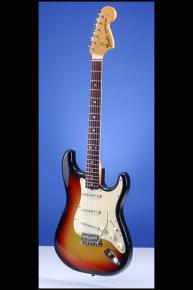A Lovely Three-Tone Sunburst Stratocaster from the Hendrix Era
This lovely three-tone Sunburst Stratocaster weighs 8.20 lbs. and has a nut width of just under 1 5/8 inches and a scale length of 25 1/2 inches. Solid alder body, contoured on back and lower bass bout. One-piece maple neck with a medium profile, and veneer rosewood fretboard with 21 frets and pearloid dot position markers. Single "butterfly" string tree with nylon spacer. Large headstock with decal logo with "Fender" in black with gold outline, "STRATOCASTER" in black beside it, "WITH SYNCHRONIZED TREMOLO" in black below it, and two patent numbers ("2,741,146" and "3,143,028") below that. Fender "F" closed-back tuners with octagonal metal buttons. Four-bolt neck plate with serial number ("279732") between the top two screws. Three single-coil pickups with staggered polepieces and perfectly balanced outputs of 5.53k, 5.53k, and 5.54k, respectively. Four-layer plastic pickguard (white/black/white/plus mother-of-pearl ("mother-of-toilet-seat") underneath) with eleven screws. Three controls (one volume, two tone) plus three-way selector switch, all on pickguard. White plastic Stratocaster knobs with greenish gold lettering. Fender "Synchronized Tremolo" combined bridge/tailpiece. The neck is stamped in green "2 37 032 B"; the potentiometers are stamped "137 7002" and "137 7014" (January and April 1970); the pickups are stamped "2 420," "9 420," and "2 420"; and the neck cavity is stamped "40". The left hand corner (approximately 1/4 inch) of the white plastic backplate is broken off by the screw. In addition, a former owner has very neatly enlarged the half-moon cutout on the pickguard between the bass pickup and the neck to allow better access to the truss-rod adjustment screw. Apart from that, there are a couple of tiny marks on the back and the edges of the guitar and a little area of wear on the treble side of the back of the neck behind the 5th fret. Otherwise this guitar is in near mint condition. There is very little fret wear. Housed in its original Fender black hardshell case with dark orange plush lining (9.00). Complete with the original bridge cover, and "Tremolo Spring" envelope.
According to Werner's List, the serial number on this guitar ("279732") corresponds to ca. October 1969
(serial numbers 279515-279804 are all listed as October 1969). Although this guitar did not leave the factory (because of the pot dates) until early 1970, it certainly has all of the features and the "feel" of a 1969 Stratocaster.
"The Stratocaster was launched during 1954 [and was priced at $249.50, or $229.50 without vibrato]...The new Fender guitar was the first solidbody electric with three pickups [Gibson's electric-acoustic ES-5, introduced five years earlier, had been the overall first], meaning a range of fresh tones, and featured a new-design vibrato unit that provided pitch-bending and shimmering chordal effects. The new vibrato -- erroneously called a 'tremolo' by Fender and many others since -- was troublesome in development. But the result was the first self-contained vibrato unit: an adjustable bridge, a tailpiece, and a vibrato system, all in one. It wasn't a simple mechanism for the time, but a reasonably effective one...Fender's new vibrato had six bridge-pieces, one for each string, adjustable for height and length, which meant that the feel of the strings could be personalized and the guitar made more in tune with itself...The Strat came with a radically sleek, solid body, based on the outline of the 1951 Fender Precision Bass. Some musicians had complained to Fender that the sharp edge of the Telecaster's body was uncomfortable...so the Strat's body was contoured for the player's comfort. Also, it was finished in a yellow-to-black sunburst finish. Even the jack socket mounting was new, recessed in a stylish plate on the body face...the Fender Stratocaster looked like no other guitar around especially the flowing, sensual curves of that beautifully proportioned, timeless body. The Stratocaster's new-style pickguard complemented the lines perfectly, and the overall impression was of a guitar where all the components ideally suited one another. The Fender Stratocaster has since become the most popular, the most copied, the most desired, and very probably the most played solid electric guitar ever" (Tony Bacon, 50 Years of Fender, p. 18).
Translate:









